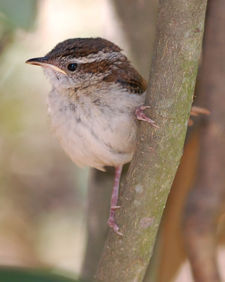Carolina wren: Difference between revisions
Chivon Morse (talk | contribs) (New page: The "'Carolina wren"' (''Thyrothorus lodvicianus'') is a small brown bird commonly found in Alabama. ==Physical Characteristics== The "'Carolina wren"' is distinguished from other small b...) |
m (Style.) |
||
| (5 intermediate revisions by 2 users not shown) | |||
| Line 1: | Line 1: | ||
The | [[Image:Carolina wren.jpg|right|thumb|225px|Carolina wren]] | ||
The '''Carolina wren''' ('''''Thryothorus ludovicianus''''') is a small brown bird commonly found in Alabama. | |||
==Physical | ==Physical characteristics== | ||
The | The Carolina wren is distinguished from other small brown birds by a distinctive white eye stripe and buff colored breast. Like most wrens, the Carolina wren has a down-curved and slender bill. The length of this bird averages 5" with a wingspan of 11.4". It weighs between 0.6 and 0.8 oz. There is no sexual dimorphism in this species, as both sexes look alike. | ||
==Natural | ==Natural history== | ||
This particular wren has a song that sounds like "tea-kettle, tea-kettle, tea-kettle" or perhaps "teacher, teacher, teacher", always with notes in threes or fours, and is often the loudest bird in the forest, despite its small size. They are found through-out most of the eastern United States in shrubby forested and residential areas. | This particular wren has a song that sounds like "tea-kettle, tea-kettle, tea-kettle" or perhaps "teacher, teacher, teacher", always with notes in threes or fours, and is often the loudest bird in the forest, despite its small size. They are found through-out most of the eastern United States in shrubby forested and residential areas. | ||
The primary diet of the | The primary diet of the Carolina wren consists of insects, but will eat some plant matter, including poison ivy berries. | ||
Carolina wrens mate for life and will build their cup-shaped nests together out of a variety of materials. These nests are usually located in cavities that are 3-6 feet above the ground, but they have been known to make nests in a variety of unusual household objects near residential areas. The female will lay a clutch of 3-7 eggs, which will hatch in 12-16 days. The young are altricial, meaning they are helpless after hatching, and will leave the nest after about 16 days. | Carolina wrens mate for life and will build their cup-shaped nests together out of a variety of materials. These nests are usually located in cavities that are 3-6 feet above the ground, but they have been known to make nests in a variety of unusual household objects near residential areas. The female will lay a clutch of 3-7 eggs, which will hatch in 12-16 days. The young are altricial, meaning they are helpless after hatching, and will leave the nest after about 16 days. | ||
==Conservation | ==Conservation status== | ||
The | The Carolina wren is listed as a species of "least concern" by the International Union for Conservation of Nature (IUCN), meaning that their populations are stable and are not under any immediate threat. | ||
==References== | ==References== | ||
Wilson | * {{Wilson-2002}} | ||
* "[http://www.allaboutbirds.org/guide/Carolina_Wren/lifehistory Carolina Wren, Life History]" All About Birds, Cornell Lab of Ornithology - accessed February 5, 2014 | |||
[[Category: Native birds]] | [[Category:Native birds]] | ||
Latest revision as of 12:11, 6 February 2014
The Carolina wren (Thryothorus ludovicianus) is a small brown bird commonly found in Alabama.
Physical characteristics
The Carolina wren is distinguished from other small brown birds by a distinctive white eye stripe and buff colored breast. Like most wrens, the Carolina wren has a down-curved and slender bill. The length of this bird averages 5" with a wingspan of 11.4". It weighs between 0.6 and 0.8 oz. There is no sexual dimorphism in this species, as both sexes look alike.
Natural history
This particular wren has a song that sounds like "tea-kettle, tea-kettle, tea-kettle" or perhaps "teacher, teacher, teacher", always with notes in threes or fours, and is often the loudest bird in the forest, despite its small size. They are found through-out most of the eastern United States in shrubby forested and residential areas.
The primary diet of the Carolina wren consists of insects, but will eat some plant matter, including poison ivy berries.
Carolina wrens mate for life and will build their cup-shaped nests together out of a variety of materials. These nests are usually located in cavities that are 3-6 feet above the ground, but they have been known to make nests in a variety of unusual household objects near residential areas. The female will lay a clutch of 3-7 eggs, which will hatch in 12-16 days. The young are altricial, meaning they are helpless after hatching, and will leave the nest after about 16 days.
Conservation status
The Carolina wren is listed as a species of "least concern" by the International Union for Conservation of Nature (IUCN), meaning that their populations are stable and are not under any immediate threat.
References
- Wilson, Jim and Anselm Atkins (2002) Common Birds of Birmingham 2nd edition. Decatur, Georgia: Hexagon Publishers ISBN 096672402X
- "Carolina Wren, Life History" All About Birds, Cornell Lab of Ornithology - accessed February 5, 2014
